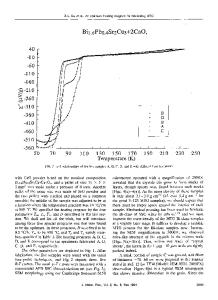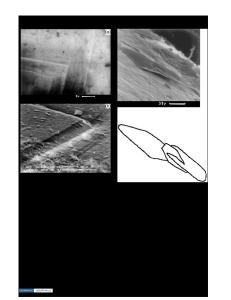Mechanical behavior of M g O-whisker reinforced (Bi, Pb) 2 Sr 2 Ca 2 Cu 3 O y high-temperature superconducting composite
- PDF / 558,890 Bytes
- 8 Pages / 612 x 792 pts (letter) Page_size
- 55 Downloads / 283 Views
MATERIALS RESEARCH
Welcome
Comments
Help
Mechanical behavior of Mg O-whisker reinforced (Bi, Pb)2 Sr2 Ca2 Cu3 Oy high-temperature superconducting composite Y. S. Yuan,a) M. S. Wong,b) and S. S. Wangc) Department of Mechanical Engineering, and Texas Center for Superconductivity, University of Houston, Houston, Texas 77204-4792 (Received 14 September 1995; accepted 11 March 1996)
The inherently weak mechanical properties of bulk monolithic high-temperature superconductors (HTS) have been a concern. Properly selected reinforcements in fiber and whisker forms have been introduced to the HTS ceramics to improve their mechanical properties. In this paper, mechanical behavior of a MgO-whisker reinforced Pb-doped Bi-2223 (BPSCCO) HTS composite fabricated by a solid-state processing method is studied. The (MgO)wyBPSCCO HTS composite has been shown to exhibit excellent superconducting properties. Elastic properties, strengths, and notched fracture toughnesses of both the monolithic BPSCCO and the (MgO)wyBPSCCO HTS composite are investigated. Detailed mechanical properties are reported for the first time for the (MgO)wyBPSCCO HTS composite. Mechanisms of strengthening and toughening in the MgO-whisker-reinforced HTS composite are also discussed.
I. INTRODUCTION
The recent development of bulk-form hightemperature superconductors (HTS) has provided a real possibility of engineering applications in the areas of current conduction and energy storage.1–4 In these applications, the superconducting materials and components are employed in cryogenic environments, where strong electric and magnetic fields commonly exist. Thermomechanical and electromagnetically induced stresses and associated deformations are expected to occur in the HTS materials. To realize these engineering applications, the HTS materials are required to possess not only desirable superconducting properties, but also acceptable mechanical properties, to sustain long-term electromagnetic and thermomechanical loading and dimensional stability. Despite their excellent superconducting properties, monolithic HTS materials are inherently brittle with low toughness and strength. For example, the fracture toughness sKIC d and flexural strength ssuts d of a melt-textured monolithic YBa2 Cu3 O72d material are reported to be approximately 1 MPa ? m1/2 and less than 40 MPa,5,6 respectively. The Bi-based monolithic HTS materials, e.g., Bi-2212 and Bi-2223, may possess better mechanical properties when fabricated by a properly selected a)
Formerly, Graduate Research Assistant; Currently with General Plastics & Rubber Co., Houston, Texas 77087. b) Senior Research Scientist, Mechanical Engineering Department, University of Houston, Houston, Texas 77204. c) Distinguished University Professor, Mechanical Engineering Department, University of Houston, Houston, Texas 77204. J. Mater. Res., Vol. 11, No. 7, Jul 1996
http://journals.cambridge.org
Downloaded: 14 Mar 2015
technique, such as hot pressing or hot forging. The sKIC d and flexural strength of a hot-pressed BPSCCO (or
Data Loading...











